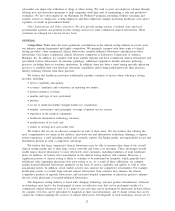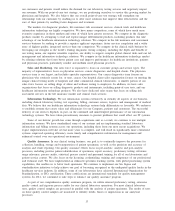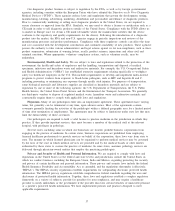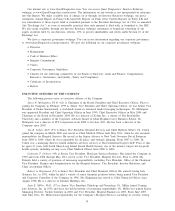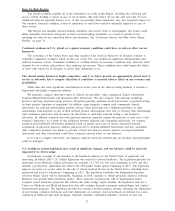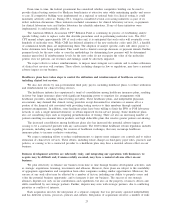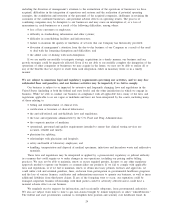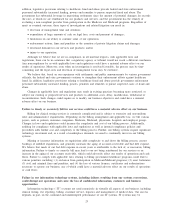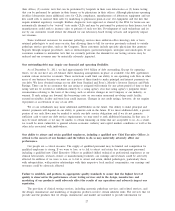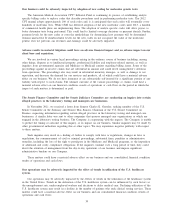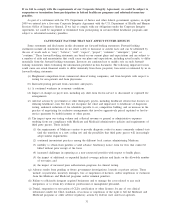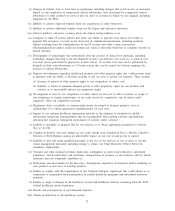Quest Diagnostics 2011 Annual Report Download - page 28
Download and view the complete annual report
Please find page 28 of the 2011 Quest Diagnostics annual report below. You can navigate through the pages in the report by either clicking on the pages listed below, or by using the keyword search tool below to find specific information within the annual report.regional health insurance exchanges, and tax subsidies for individuals to help cover the cost of individual
insurance coverage. The legislation also permits the establishment of accountable care organizations, a new
healthcare delivery model. While the ultimate impact of the legislation on the healthcare industry is unknown, it
is likely to be extensive and may result in significant change. Our failure to adapt to these changes could have a
material adverse effect on our business.
Our business could be negatively affected if we are unable to continue to improve our efficiency.
Government payers and healthcare insurers have taken steps to control the utilization and reimbursement of
healthcare services, including clinical testing services; such steps may continue. If we are unable to continue to
improve our efficiency to enable us to mitigate the impact on our profitability of these activities, our business
could be negatively affected.
Our business could be adversely impacted by the FDA’s approach to regulation.
During 2011, the FDA issued several draft guidance documents related to our business, including, among
others, guidance documents regarding software applications used for handheld devices, companion diagnostics,
products labeled RUO and IUO and enhancements to the 510(k) process.
Laboratories use analyte specific reagents (“ASRs”) in some LDTs. Under current FDA guidance,
manufacturers of certain products marketed as ASRs must comply with FDA regulations in order to be marketed
in the United States. In its draft guidance on RUO and IUO labeled products, the FDA proposes to increase its
scrutiny of reagents, kits, instruments and software labeled RUO and IUO, and threatened to take regulatory
action against manufacturers who know or should know that laboratories are using them in clinical diagnostics
testing.
During 2012, the FDA plans to issue three guidance documents regarding regulation of LDTs and clinical
laboratories. The first concerns how laboratories will register and list LDTs with the FDA, the second sets forth
the risk-based scheme for LDT classification and the third advises laboratories how to become compliant with
Quality Systems regulations.
If finalized, each of the FDA’s guidance documents could have a significant impact on our business. For
example, the proposed guidance regarding RUO and IUO labeled products could result in increased product cost,
a delay in obtaining needed supplies, or, if a manufacturer withdraws its products from the market, an inability to
obtain the supplies. The FDA’s guidance documents may hinder our ability to develop and market new products
or services or cause an increase in the cost of our products or services. They also may hinder our ability to
perform tests. These matters could have a material adverse effect on our business and our consolidated financial
condition, results of operations and cash flows.
Government payers, such as Medicare and Medicaid, have taken steps to control the utilization and
reimbursement of healthcare services, including clinical test services.
We face efforts by government payers to reduce utilization and reimbursement for clinical testing services.
From time to time, Congress has legislated reductions in, or frozen updates to, the Medicare Clinical
Laboratory Fee Schedule. In addition, CMS has adopted policies limiting or excluding coverage for clinical tests
that we perform. We also provide physician services which are reimbursed by Medicare under a physician fee
schedule, which is subject to adjustment on an annual basis. CMS changes add to our costs by increasing
complexity and administrative requirements for billing. Medicaid reimbursement varies by state and is subject to
administrative and billing requirements and budget pressures. The 2010 federal healthcare reform legislation
includes further provisions that are designed to control utilization and payment levels.
In addition, over the last several years, the federal government has continued to expand its contracts with
private health insurance plans for Medicare beneficiaries, called “Medicare Advantage” programs, and has
encouraged such beneficiaries to switch from the traditional programs to the private programs. There has been
continued growth of health insurance plans offering Medicare Advantage programs, and of beneficiary enrollment
in these programs. Also in recent years, states have increasingly mandated that Medicaid beneficiaries enroll in
private managed care arrangements. The 2010 federal healthcare reform legislation is intended to control the
growth of Medicare Advantage programs, encourage beneficiaries to switch back to traditional Medicare programs
and expand the eligibility for traditional Medicaid programs. Recently, state budget pressures have encouraged
states to consider several courses that may impact our business, such as delaying payments, reducing
reimbursement, restricting coverage eligibility, service coverage restrictions and imposing taxes on our services.
22


